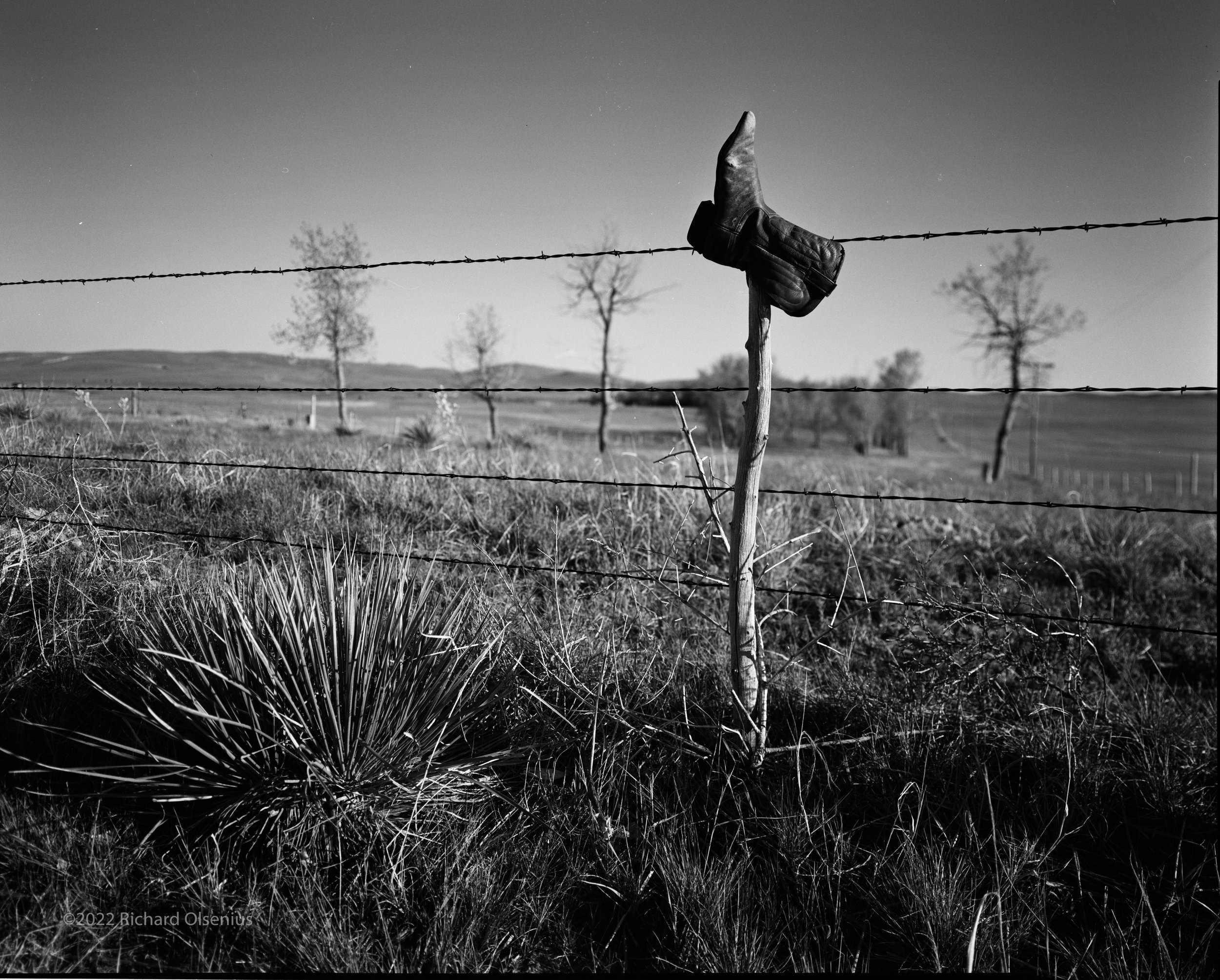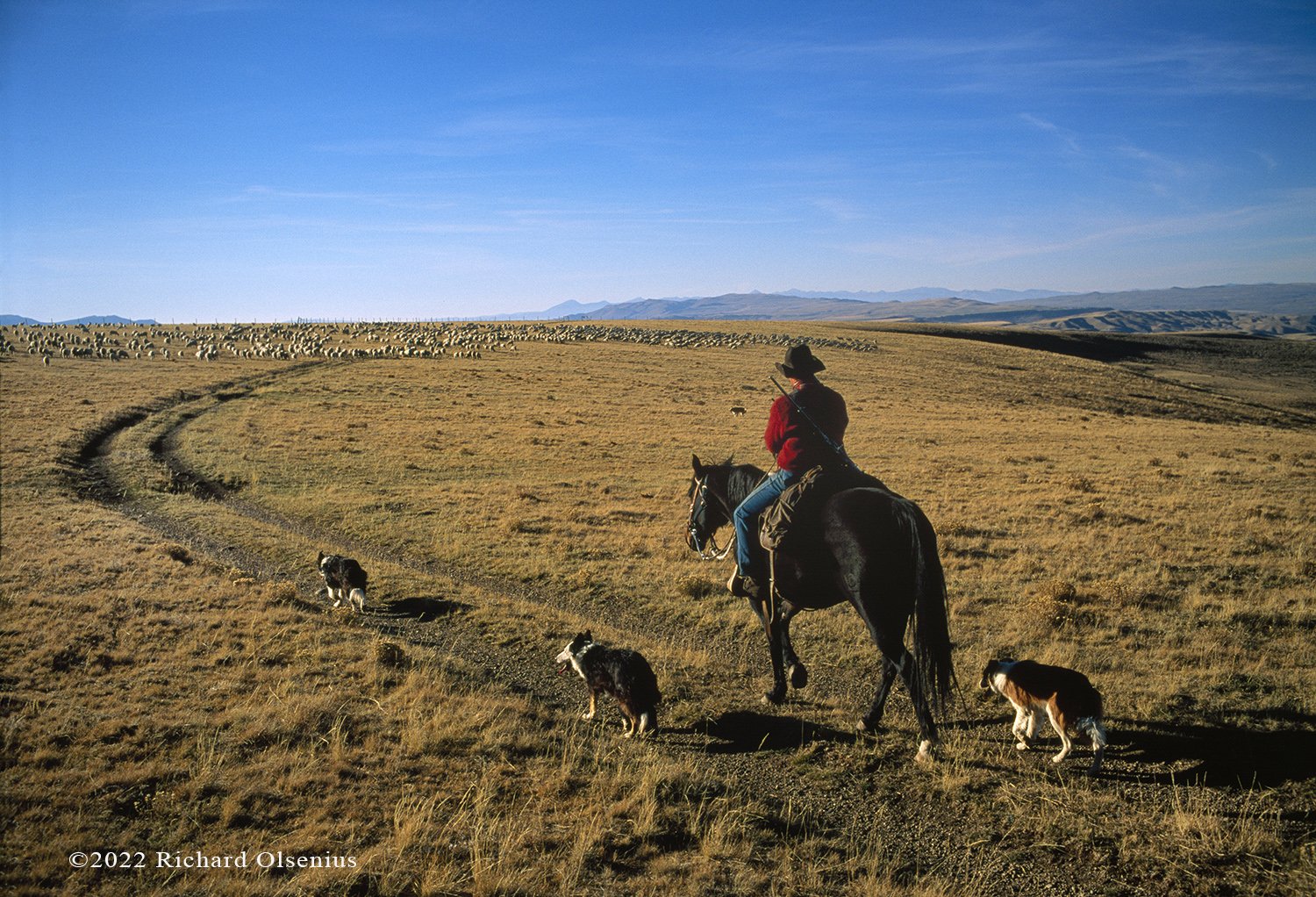
The American Cowboy -
Stories and Mythology
by Richard Olsenius
As a photojournalist for over 50 years, I was always drawn to the American West, to the rolling prairies beyond the Missouri River, to a land that slowly rose to meet the continental divide. And along the way, seed caps morphed into stetsons and Red Wing boots into cowboy boots. Farms not able to survive the drier climate, gave way to open range land for cattle and sheep. And the land held a new gold rush of coal, oil and gas development. Then there were the newer entrepreneurs starting businesses in everything from chili making to gun-smithing.
As I traveled down many remote roads and boom towns gone bust, I learned that landscape is the key to understanding the West. Writer Lawrence Durrell once said, "To know a people you need only a little patience, a quiet moment and a place where you might listen to the whispered messages of their land."
My perception of the American West is a blend of romanticized, mythical ideas (like cowboys riding freely across vast plains) and the actual, sometimes harsh realities of life in the region, where the landscape itself remains a constant backdrop connecting these different visions.
So what is this "mythology vs. reality" balance in the American West that I sought with my photography and stories?
Mythical elements:
Images of rugged cowboys, lone frontiersmen, wide-open spaces, dramatic landscapes, and heroic battles against Native Americans are often portrayed in movies, literature, and popular culture, creating a romanticized view of the West.
Real aspects:
The reality of the American West includes the harsh realities of pioneer life, struggles with land ownership, conflicts with Native American tribes, harsh weather conditions, and the hard labor involved in settling the land.
Importance of the landscape:
Regardless of the specific story or characters that I photographed, the vast and diverse Western landscape served as a unifying thread, acting as a symbol of freedom, possibility, and the untamed wilderness that resonated with me.

American
Cowboy
by Richard Olsenius

Cowboys and Other Western Stories
(This is a letter to my editor, Dave Arnold at National Geographic Magazine about a story on Wyoming I was working on.)
Dear Dave (Arnold),
I'm home from the range, so I thought I'd let you know. I don't think we're done there, but after a couple of months I needed a bit of distance. You should have a bunch to look at, rodeos, winter snow at Elk Mt., Basque Sheepherder, Hot Springs, an aerial or two, snowmobiling, Yellowstone Cafe or Shoshoni, Jeffrey City, moving sheep, and another 80 rolls that should have arrived yesterday from the Miller ranch in Big Piney. There should be a few good frames from that ranch. But things have slowed down out there and everyone is waiting for calving, lambing and branding. Winter so far out there has never really hit. I don't know about you, but with a little from our late summer shoot, the winter collection and a bit from spring, I think there is a good story about a unique part of this country. I can see it in the people pictures. Don't you think I should come out to D.C., go through a few yellow boxes and you and I have a good talk?
Richard
Kathi Voils plays her guitar in the Spotted Horse Bar, Wyoming. 2022 Richard Olsenius
John Wayne point where visitors to Monument Valley come to see the West. 2022 Richard Olsenius

Moving Sheep down to their winter range from the Gravely Range, Montana.
A Nebraska ranch family and their morning ritual of allowing their daughter to climb in bad with them. This was photographed with permission for the “Day In The Life of America” book project.
Notes from the Field.
That’s the way it once worked at National Geographic. You would go out in the field, which in this case was Wyoming, working alone with occasional contact with the writer and my picture editor. But most often it was driving down endless roads, passing through small towns looking for anything that might make a photograph, a statement that would reinforce the feelings that I was experiencing. It was lonely at times and that forced me to explore the local gathering spots; bars, stores, long ranch roads, cafes, stockyards, and evening rodeos with many just located down the street from the Holiday Inn.
But slowly I gained confidence in just walking up to a door and saying, “Hi, I’m from National Geographic and I’m doing a story about the people in the West.” I never stopped being amazed when I heard back, “Well come on in.” More Field Notes Here.
Convergence in Deadwood
There was a time in Deadwood, South Dakota when I ended up in a bar sitting next to a biker lady with a deep dent in her forehead. I was smoking then and I remember taking a deep drag and asking, like I often do, a question that few would ask. “How’d you get that dent in your forehead?” She answered without missing a beat, “my ex shot me.” I don’t know if that was true or not, but I ended up taking a photograph of her and her boyfriend outside the bar sitting on their Harleys surrounded by the rest of their group called the “Outlaws” whose base was somewhere near Chicago. They had taken all their clothes off. I had no choice but to take that photo. At the same time a minivan from some place like Ohio, was driving by with three children hanging out the windows on this hot day. I was backed half-way out in the street and I remember hearing the mom telling her husband to “step on it.” I think he had slowed down to take a look. The biker couple quickly dressed, demanded the roll of film and of course, I gave it to them.
A Wyoming ranch along the Front Range of the Rocky Mountains.
So why am I telling you this? Because it was at that moment in one of the doorway’s to the West, Deadwood, South Dakota, that three separate people, none of which were from the West, crossed paths. We were in search of a Western experience, to fulfill our vision of the cowboy, the big ranch, the western town with sage brush stuck against aging buildings and more. So there we were all out on this journey; a minivan family, Midwest biker gang and a National Geographic photographer, all looking for a similar experience. The difference here is that it was my luck to spend many months talking to locals, searching for cowboys and sheepherders down lonely ranch roads, and spending many nights in one-story motels listening to doors opening and closing throughout the night.
So now at this later point in my life, I want to revisit my journeys down those lonely roads and the people I’ve met and stories I’ve heard - collecting the portraits, the cowboy images and special moments into this visual notebook of my travels through the West. I’m sure many things have changed from those days, but I have a strong feeling that in many ways they have not.
Homes and families living down dusty roads are invisible to those speeding by.
There is always the chance encounter of cattle on the highway, being moved to a new range.
American Cowboy Galleries
The Following Chapters are under construction - ready April 2022 - RETURN TO COLLECTIONS














